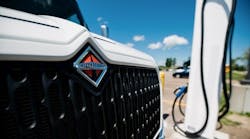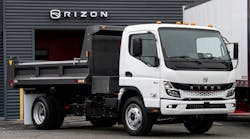“Alternative power is a topic which will change the world,” said Martin Daum, president and CEO of Daimler Trucks North America (DTNA), “and at DTNA, clean energy is and will be very important for years to come...”
Daum was the keynoter at the Alternative Clean Transportation Expo in Long Beach, CA, produced by Gladstein, Neandross & Associates. “How exactly to get to that clean energy future is not yet clear,” Daum told the audience, “but we have spent $2.2 billion so far in getting our company in that direction…and we are proud to be a part of the team of [clean power] experts worldwide.”
Daum went on to talk about DTNA’s long history of work to achieve fuel efficiency, but noted that, “The customer is the one who decides if we are serious or not about fuel efficiency.” Over 2,500 alternative drivetrains have been sold by DTNA thus far, and by April 2011, the company was already ahead of last year’s record, he said.
In his address, Daum also discussed DTNA’s role in many diesel efficiency programs and alternative fuel options, making specific note of the company’s achievements in these sectors, including BlueTec Emissions technology, hybrid technology and bringing the earliest factory-produced conventional natural gas trucks to market.
“We are really glad to have a broad array of natural gas options available, including Thomas Built hybrid and CNG buses,” he noted. “That is very important to me. Buses work about 28 years and they drive through the neighborhoods with exhaust at the levels of our kids….
“All this is current technology, however,” Daum told the audience. “Nobody [cares] about the past if you can’t deliver on the future. We were also very involved in the Super Trucks program, which looks at aerodynamics, weight, productivity-focused technologies, engine thermal management, parasitic loss reduction and more. The goal of the program is to achieve a 50 percent improvement in efficiency and a 50 percent decrease in emissions. I believe this is possible.”
To that end, he noted that DTNA is among those supporting the recent ATD initiative to eliminate the excise tax on new alternative power vehicles as a means to help accelerate their development and adoption. “We punish alternative energy options and why?” he asked the audience. “We put more technology into the trucks and then they cost more and then people must pay more excise taxes…If we got rid of those, we would go a huge way [toward furthering alternative power].” Under the ATD proposal, a slight increase in diesel fuel taxes could offset the loss of the excise tax revenue.
Daum also stressed the need for building out the fueling infrastructure for alternative power vehicles. “It is easier to build trucks if we can overcome the worry about running out of fuel,” he said.
For the future, Daum said that the company is also starting to work on all-electric vehicles and he thanked public and private-sector partners for their past and ongoing support of the company’s efforts to build cleaner, more efficient trucks. “We have enjoyed a constructive and productive relationship [with DOE, EPA, CARB, the South Coast Air Quality Management District (SCAQMD) and others],” he said. “They invested in this before anyone else believed in it.”
He also recognized numerous bellwether fleets for their leadership in this area. “After the public sector, which went first, the private sector stepped up,” Daum said. He mentioned Ryder, Coca-Cola, UPS, Sysco, FedEx, Nestle Waters, Aramark and others and apologized that there was not time to personally thank everyone who has made a difference.
Later, Daum told Fleet Owner, that there are three types of innovation: innovations that improve efficiency and make trucks lower cost, which have already been done; innovations that can deliver a 2% to 4% improvement in fuel efficiency and offer a payback within 2-4 years; and “non-feasible innovations,” technologies which need diesel to be at $10 per gallon or more to justify the investment.
The non-feasible projects might be demanded by regulation or forced by Congressional action, he noted, but added that was the problem with using regulations to push specific technologies forward. “You might inadvertently misguide the innovation process and force development down the wrong path,” he said, adding that was why incentives for innovation were a preferred approach to regulation.

